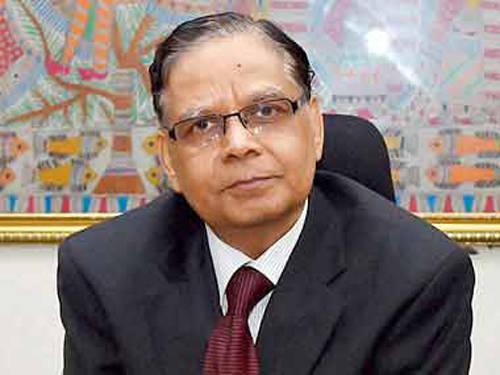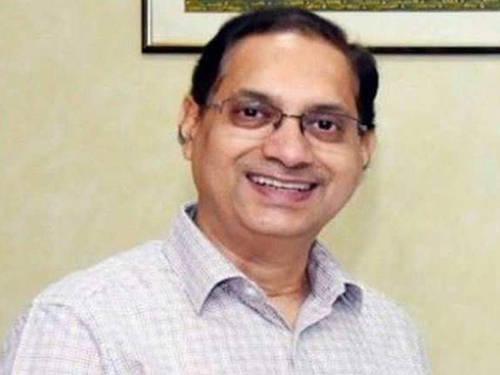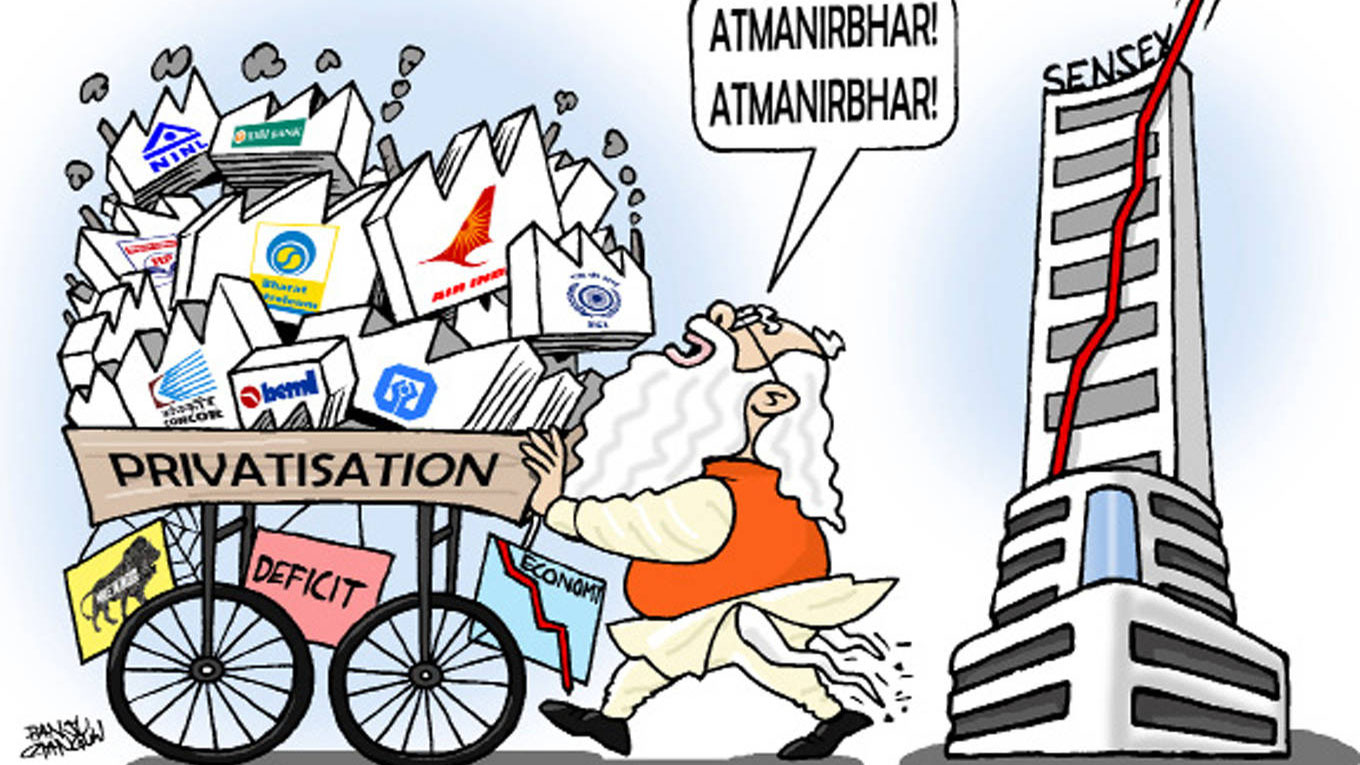-

Sitharaman: privatisation process will take off
The tragedy is that, in its hurry, the government is giving short shrift to retail investors. For instance, in the last-minute offer for sale (OFS) of 10 per cent SAIL stake to rustle up the much-needed revenue, the retail portion was kept at just 12.5 per cent, instead of, say, a healthy 50 per cent.
Indeed, if the government is serious about using privatisation as a reform tool in the coming year, it will have to give up its habit of exploiting disinvestment for merely filling up a hole in the Consolidated Fund of India. For real revival, the government should exploit the benefits of privatisation in terms of better use of land, labour and capital that will bring productivity gains to the economy. Sitharaman’s upcoming budget will indicate how serious the government is on this count.
Low valuation
For any government that wants to make a success of privatisation, there are three aspects that need to be decisively tackled – lack of political intent, bureaucratic reluctance and low valuation. While the government appears to have come to grips with the first two aspects by stating its objectives clearly and resolving to stand by civil servants, who are reluctant to take decisions that may be questioned many years after they have retired, it is the third aspect that will need extensive tackling. State-run companies have traditionally targeted raising output and increasing revenues, rather than improving efficiency and valuations, contributing to years of share price underperformance versus the broader market. It is only now that the government is thinking of setting tough financial targets for PSUs to improve their performance (see box: Getting PSUs into shape).
Targets will be set on metrics such as earnings before interest, depreciation, tax and amortisation (EBIDTA), according to a document on the draft guidelines, which is currently before a government committee. Other targets will include increasing market capitalisation or share price, as well as measures such as return on net worth and capital employed. PSUs should be told to deploy funds raised through asset monetisation for issues like debt repayment. This thrust on PSU reforms may also get reflected in Budget 2021-22.
Of course, there is another element – plain good luck. To get the disinvestment process really going, one needs a few success stories, says Pradip Baijal, who served as disinvestment secretary under Shourie.
Experts weigh in
Pressure was building up on the government to bite the bullet on privatisation. In the middle of the pandemic last year, Raghuram Rajan, former RBI governor, raised a valid question: “If the stock market is buoyant, why aren’t we selling PSUs at this point? Are we waiting for the stock market to come down to start selling more?” Recently, almost six months later in its budget recommendations for 2021-22, industry body CII asked the government to go ahead aggressively with the disinvestment process of both loss-making and a few profit-making PSUs, given the fact that the capital markets are performing well. CII also recommended sale or leasing of government’s surplus land. With the Sensex breaching the psychological mark of 50000 and investor appetite growing, there is no reason the government should not expedite the process.
Agreed, this year’s disinvestment target went off the rails because between 1 February 2020 (when the budget was presented in Parliament) and March-end (when the pandemic formally arrived), fears of recession triggered by the corona-virus spooked the global stock markets. In fact, on 23 March, the Sensex lost 3935 points, bringing it to the lowest levels since 2016. This rattled the finance ministry and those overseeing the disinvestment process no end. But the bulls were back by the middle of the year. By August, the valuations were at an all-time high. There couldn’t have been a better time to go in for privatisation.
-
You need to strengthen the governance and then sell the shares more publicly, so that it becomes a publicly owned company and can then depart from the strictures that the government ownership imposes on it
But Sitharaman and her officials got it wrong. They believed the then stock prices were not a true reflection of the expected future company earnings, which the pandemic was bound to negatively impact. RBI governor Shaktikanta Das also fanned the fears by talking of a great disconnect between the state of the stock market and the real state of the economy. Das also felt that there was ‘definitely a correction ahead’. They were off the mark, as corporate profits in the September quarter rose 15 per cent, as margins widened on softer input costs and better utilisation levels. So far, even the December quarter earnings have been decent.
LIC IPO delay
The statements led to, among other things, delay in the blockbuster IPO of Life Insurance Corporation, expected to be the biggest in the Indian stock market. The bill to amend the LIC Act, which will facilitate the IPO never made it to Parliament. A 10 per cent stake sale could have netted the government R90,000-100,000 crore. However, it was only towards the end of August 2020 that the government appointed SBI Caps and Deloitte as the pre-IPO inspection transaction advisors. The pre-IPO process of the country’s largest insurer is also taking time because of technicalities involved in actuarial valuation and valuation of huge real estate assets of the company. The blockbuster IPO is now expected to come by mid-year.
The government also clung on to its stake held through the Specified Undertaking of the Unit Trust of India (SUUTI) in companies like Axis Bank Ltd (11.53 per cent), hotels-to-personal care conglomerate ITC Ltd (7.93 per cent), and construction engineering company Larsen & Toubro Ltd (1.8 per cent), paring it down in driblets. For instance, SUUTI took advantage of the buoyancy in the equity market and sold 6.14 million shares of Axis Bank during 2-4 December, fetching the government Rs374.21 crore. And, during 26-27 November, it sold another 3.63 million shares for Rs221.47 crore.
The government’s stake in Axis Bank and ITC alone was worth R22,000 crore last year. Besides, SUUTI owns stake in 51 companies for the government. Of these, stakes in NSDL, STCI Finance, UTI-IAS, North Eastern Development Finance Corporation, Stock Holding Corporation of India, UTI Infrastructure Technology Services, NSDL e-Governance Infrastructure and Over-the-counter Exchange of India are significant. Why not get rid of it all?
Official reason
The official explanation for the delay is that strategic disinvestment is a long-term commitment of investors, requiring deep engagement. Normally, it takes a minimum of 8-9 months to sell a company. To a large extent, Covid-19 put a brake on this, because international travel virtually stopped and investors, engaged in fire-fighting back home, had to recalibrate their plans.
For instance, the sharp dip in crude prices saw global oil majors like Saudi Aramco lose interest in oil marketing major BPCL. So, the government had to grant extension to some of the Expressions of Interest (EoIs). Investors too wanted more time in the case of Air India as the aviation business was virtually paralysed during the pandemic.
In any case, as officials say, the run rate of disinvestment mop up is always slow in the first nine months, but then typically, it is the January-March period that sees conclusion of some deals.
What can the government do to expedite the process? As disinvestment is also about optics, the government needs to step in more purposefully. In an interview shortly after Modi’s electoral victory in 2019, Arvind Panagariya, the Indian-American economist, who served as vice-chairman, NITI Aayog, during 2015-17, suggested that the government should privatise one PSU per week as proof of its intentions to turn a new corner. This was feasible as over two dozen PSUs already had the cabinet approval for privatisation. Panagariya’s suggestion can now be modified to make it still more feasible – one PSU can be privatised every month.
-

Sanyal: all nonstrategic PSUs will be sold
Also, the government will do well to seriously consider the latest suggestion made by him in his column – reviving the ministry of disinvestment that existed during the Vajpayee era. Once that is done, Modi should place an outside technocrat of unimpeachable integrity and proven ability in charge of the ministry – with a clear mandate to move the privatisation project forward at a rapid pace. Panagariya feels that one such candidate for the job could be Aditya Puri, former CEO of HDFC Bank.
Sell-off pipeline
Of late, the government has been repeatedly underlining the resolve to get things done, differently. “We are building a strategic disinvestment pipeline,” says Tuhin Kanta Pandey, secretary, Department of Investment & Public Asset Management (DIPAM), which is now the nodal department for the strategic stake sale in PSUs. This is being done with a view to streamlining and speeding up the process, reducing the role of administrative ministries, which often used to place hurdles in the path of major stake sales.
The sentiment is echoed by private players. “The government has got aggressive with respect to the privatisation of PSUs to unlock their valuations and meet the divestment goals to keep the fiscal deficit targets intact,” says Gaurav Garg, head, research, CapitalVia Global Research. “Privatisation would also help the PSUs in becoming more competitive and efficient.”
Undeterred by trade union calls for a pause on privatisation and other sweeping policy reforms, the government is considering boosting private participation in other spheres as well. The transport sector is witnessing significant changes. Our ageing Railways is one such area, where private participation is now being allowed in including, among other things, redevelopment of select railway stations.
One suggestion is to levy airport-like user charge on users of these redeveloped railway stations. V.K. Yadav, chairman, Railway Board, dismisses the speculation that this will translate into costlier rail travel. “The user charge will be nominal. Also, the charge will be applicable only for redeveloped stations. Not all stations are being redeveloped at present.” On the issue of private players being able to determine their own fares — as it has been decided by the Indian Railways — he says that, as there will be competition from bus fares and air fares, private players will, in no circumstances, charge exorbitant fares.
The private sector is also moving into cargo operations in major public ports where container handling is already dominated by build-operate-transfer (BOT) operators. The government view is that some of the major ports have further room for ‘landlord leverage’ to scale up, thereby improving capacity utilisation at state-owned cargo handling facilities that have suffered steady volume declines and are caught up in a growth quagmire.
India has 12 Central government-owned gateway ports dotting its east and west coasts, which together handle about 60 per cent of the country’s containerised trade. With the exception of the Ennore Port (renamed Kamarajar), near Chennai, major port trusts widely follow a hybrid business model — providing cargo services themselves and, secondly, acting as landlords to private concessionaires. Ennore is governed by a board of directors, akin to a typical corporate entity. There are about 270 cargo berths across these major ports, most of which are state-owned and designed for general cargo operations. These will now see private participation.
-

Panagariya: revive the disinvestment ministry
Adani on top
Though airports privatisation began in 2006, with the Mumbai and Delhi airports, it gained a new lease of life recently. In the first round of airports’ privatisation under the Modi government, the Adani group bagged contracts for six airports last February – Lucknow, Ahmedabad, Jaipur, Mangaluru, Thiruvananthapuram, and Guwahati – by huge margins. After acquiring 74 per cent stake in Mumbai International Airport, the Adani group now controls seven airports in India. This makes it the biggest private operator in this space in terms of the number of airports.
However, the process has not gone through without a political glitch. The Left Democratic Front in Kerala challenged the privatisation process as a case of ‘cronyism’. After the high court dismissed the petition, the LDF has now moved the Supreme Court.
That is not all. After the Airports Authority of India (AAI), which works under the Ministry of Civil Aviation, recommended the privatisation of airports at Amritsar, Varanasi, Bhubaneswar, Indore, Raipur and Tiruchirappalli, another glitch surfaced. There were reservations that the policy of privatising profit-making airports will saddle the AAI, which owns and manages more than 100 airports across the country, with economically unviable airports and foster monopoly in the sector.
So, a proposal has been floated that, in the upcoming round, unviable airports should be clubbed with six main airports and a prospective bidder may be restricted to bid for two airports. If the proposal goes through, Varanasi will be clubbed with Kushinagar airport, Bhubaneswar will be attached with Jharsuguda, and Indore, Amritsar, and Tiruchirappalli airports will be clubbed with Jabalpur, Barmer, and Salem airports, respectively. But will there be any takers for airports, which came up in the first place because of political reasons?
Mixed start
When privatisation was flagged off last year, it wasn’t exactly strategic sale for some of the listed PSUs in the sense of vesting control of these companies in private hands. For instance, the Centre’s stake in THDC India (Tehri Hydro Power Development Corporation) and NEEPCO (North Eastern Electric Power Corporation), two of the identified PSUs, went to NTPC. This was the easy way out, as all three PSUs were under the purview of the Power Ministry and NTPC had enough cash reserves to buy out THDC and NEEPCO. In the bargain, the government netted Rs11,500 crore.
That’s been the story in earlier years also. For example, the Hindustan Petroleum shares were sold to Oil & Natural Gas Corporation. And, even for the IPOs of PSUs, amid little public interest, the LIC with its deep pockets was called in to buy shares.
Indeed, ever since the Vajpayee government ceded ownership of a handful of PSUs to private buyers in 2001-02 and attracted criticism for its pricing and choice of buyers, most governments have pussy-footed around the concept of PSU disinvestment. The disinvestment programme over the last 15 years has largely centred around dribbling minority stakes in PSUs into the market, without the government really ceding control. Also, there were inconsequential stake sales through the ETF route, as well as the above-mentioned left-pocket-to-right-pocket transfers between PSUs, which served little purpose, other than numerically meeting disinvestment targets.
-
A successful sale of Air India will send a strong message about the seriousness of the government’s strategic sale plan
Reflecting the government’s changed stand now, Pandey says that strategic disinvestment by way of privatisation is key to DIPAM’s plans. As for the strategic disinvestment pipeline, the concept is important because that could add a lot of value not only to stocks of existing PSUs, as management control will be passed on to private hands, but also to the philosophy – which one heard from Prime Minister Modi when he first assumed office in 2014 – that the government has no business to be in business.
On 17 May, the government had announced a disinvestment plan as part of the Atmanirbhar Bharat package, saying it would keep a maximum of four PSUs in strategic sectors of the economy. This plan is unlike previous attempts to disinvest. In the past, the government would come up with an identified list of PSUs to privatise. This time, it is the other way round. The government will keep some PSUs in strategic sectors and disinvest everything else. It was announced that a new Public Sector Enterprises (PSE) policy, where a list of strategic sectors will be notified, was in the works. The policy has been delayed, disappointing observers and investors. But recently, Tarun Bajaj, secretary, department of economic affairs, revealed that the wait would be worth it. “This policy would be more ambitious than anticipated,” he said. “It will bring about a paradigm shift”.
Meaningful activity
The last few weeks have seen some meaningful activity. In November, the government finally took the first step in the process to privatise oil marketer BPCL by inviting EoIs. While big players like Reliance, Total, Aramco or BP remained away from it, the government is encouraged by the prospect of mining major Vedanta, among others, showing interest. This was followed by the government again receiving EoIs for Air India, including a bid from Tata Sons, and one from a consortium of the airline’s employees and the US-based investment firm Interups Inc. This is the government’s second attempt at disinvesting its stake in Air India, the earlier attempt in 2018 having ended badly. Not a single bid was received for the debt-laden airline then. So, a lot is at stake, including the government’s reputation.
Some say that BPCL could be a turning point for the disinvestment process, as it is a revenue churner for the government, rather than a drain on its finances. One reason the sale could go through is that, from the outset, the government has said that it would sell its 53 per cent stake in BPCL only to a private player. Through the sale of BPCL, the government is expecting to earn about R40,000 crore.
As for Air India, in 2018, the government had put up 76 per cent stake for sale, along with a portion of its debt. This time, it plans to divest 100 per cent of its equity share capital in Air India Limited, which includes Air India’s shareholding interest of 100 per cent in Air India Express and 50 per cent in Air India SATS Airport Services. Again, a successful sale of Air India will send a strong message about the seriousness of the government’s strategic sale plan.
-

Shah: follow the ‘Maruti model’
The government is likely to open invite bids for privatisation of SCI shortly and buyers will be given time till mid February to submit EoIs. The government plans to sell entire 63.75 per cent stake in SCI, along with transfer of management control. At the current market price, the government’s stake in SCI is valued at Rs2,500 crore.
As Panagariya points out, while the list of disinvestment candidates is large, the government just has to get its act together. For instance, the government has cleared in principle the disinvestment of leading PSUs like Indian Oil, NTPC, Power Finance Corporation, Power Grid Corporation India, GAIL, NALCO and Bharat Electronics. But it is yet to decide whether stakes in these companies should be pared down by 51 per cent.
Predictable murmurs
While the decision of the Modi government in its second term to revive the idea of genuine disinvestment through strategic sales of its majority stakes in profitable PSUs to private buyers has won plaudits, there are predictable rumblings of protest from PSU insiders, who are likening the disinvestment of profit-making PSUs to the ‘sale of family silver’ and flagging the risk of cronyism. As such, the Centre will have to stick to its guns with its view that the ‘government has no business being in business’. While strategic sale deals in the past have seen a few mis-steps, they’ve also yielded convincing success stories like Hindustan Zinc’s, which has seen a hundred-fold increase in its profits on the back of a six-fold expansion in capacities, since its takeover by Vedanta in 2002.
To allay concerns of cronyism, the strategic sale process needs to be transparent, with a minimum reserve price that does justice to the valuable assets being auctioned off. A third-party valuation of every PSU’s assets and a minimum number of bidders (say five), should be necessary pre-conditions to going ahead with each sale. It is also necessary for the government to recognise that, when it cedes majority equity in profit-making entities, it is effectively giving up substantial future rights over these firms’ earnings and dividend payouts, which result in a substantial opportunity cost to the exchequer.
To offset this, it would be best to sequester the substantial sums raised from such strategic sales from the union budget, so that they aren’t frittered away in interest or salary payouts or used for balancing the fisc but are reinvested prudently in long-term infrastructure assets that can yield enduring returns to the economy. The government already has a ready-made sovereign wealth vehicle in the form of the professionally managed National Investment and Infrastructure Fund, into which it can redirect these disinvestment proceeds.
-
To allay concerns of cronyism, the strategic sale process needs to be transparent, with a minimum reserve price that does justice to the valuable assets being auctioned off
The government can turn to a number of models to suit its convenience and market conditions. For instance, Nilesh Shah, MD, Kotak Mahindra Asset Management, and member, PM’s Economic Advisory Council, feels that in carrying out privatisation, the government should follow what he calls the ‘Maruti model’. This means the government must reduce its holding to minority stake levels and ensure that good private management takes over. Later, when the share value of the company increases, the government can sell off its minority stake at a sizeable profit.
Another approach is to bypass the public sector completely and allow the unfettered entry of private players in other sectors. In banking, for instance, the government can avoid PSBs completely and give a big push to private banking by issuing new bank licences. In this context, Sudipto Mundle of NCAER points to the recent report on Ownership and Corporate Structure for Indian Private Sector Banks submitted by an RBI internal working group (IWG), which espouses this approach. Apart from many recommendations on better prudential regulation, strengthening the supervision capacity of RBI, etc, the IWG’s main and most controversial recommendation is to enable large corporations and industrial houses to acquire banking licences.
Mundle, however, feels that a safer and cleaner option would be to help the country’s banking sector grow through simultaneous privatisation and recapitalisation of PSBs. Raghuram Rajan says that, irrespective of the model, the underlying philosophy should be about improving governance in companies hitherto run by the government. “Some people would say there is no alternative to privatisation, but it is not clear to me that privatising and having some big entity taking over and mismanaging the process is necessarily a good thing either. You need to strengthen the governance and then sell the shares more publicly, so that it becomes a publicly owned company and can then depart from the strictures that the government ownership imposes on it.”
These are all wise words from wise men. One can only hope that the government is listening.
-

Pandey: do an introspection
Getting PSUs into shape
A key aspect of the government strategy before putting the PSUs on the block is to whip them into shape. Speaking at a virtual summit organised by the Confederation of Indian Industry, Tuhin Kanta Pandey, secretary, DIPAM, said that the PSUs should do introspection about low stock market valuation and constantly engage with investors in a bid to yield better share prices. A point of concern has been that between March and November 2020, while Sensex and Nifty have risen about 50 per cent, there has been a rise of only 19 per cent in the BSE-CPSE index. Indeed, the BSE-CPSE index has been falling behind Sensex.
So, in general, there is a problem of PSU stock valuation in the market. This has to change. Pandey wants the PSUs to do an atmachintan (introspection) as to why the problem is arising and whether it is due to ‘inherent problems in managing companies’ or is it because of government policy issues. “We must introspect and ensure investors who invest in the PSU space are equally rewarded and not short-changed,” the secretary said.
DIPAM has now asked PSUs to include asset monetisation and market capitalisation improvement as two indicators in the memoranda of understanding that is signed with the administrative ministry.







































